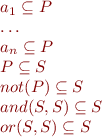Definition of Set Constraints
Set constraints are a logic used in program analysis. In set constraints, each variable denotes a set of ground terms.
Let  be a language of function symbols and constants. We write
be a language of function symbols and constants. We write  for an element of
for an element of  . Let
. Let  be the set of ground terms in language
be the set of ground terms in language  .
.
Syntax of Set Constraints

where
 - set variable
- set variable - standard set operations and relations
- standard set operations and relations - function symbol
- function symbol- in
 ,
,  is an integer between 1 and arity of
is an integer between 1 and arity of 
Semantic
 - set variable, subset of
- set variable, subset of 
 - standard set operations and relations
- standard set operations and relations

Example1

Example2

Example3
What is the least solution of constraints

where  is constant and
is constant and  is unary function symbol.
is unary function symbol.
Example4
What is the least solution of constraints

where  is constant,
is constant,  are unary function symbols.
are unary function symbols.
Example5
Let  where
where
 are constants representing propositional constants
are constants representing propositional constants is unary function symbol representing negation in abstract syntax tree
is unary function symbol representing negation in abstract syntax tree are binary function symbols representing
are binary function symbols representing  in syntax tree
in syntax tree
Then the set of ground terms  represents propositional formulas.
represents propositional formulas.
What does the least solution of these constraints represent (where  ,
, are set variables):
are set variables):

Existence of Solutions
We were able to talk about “the least solution” because previous examples can be rewritten into form

where  is a
is a  -morphism (and therefore monotonic and
-morphism (and therefore monotonic and  -continuous). The least solution can therefore be computed by fixpoint iteration (but it may contain infinite sets).
-continuous). The least solution can therefore be computed by fixpoint iteration (but it may contain infinite sets).






